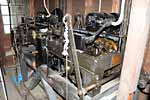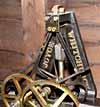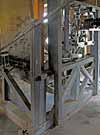Southwell MinsterClock
 Clock mechanism Clock mechanism |
 Detail of mechanism Detail of mechanism |
 Chime barrel mechanism Chime barrel mechanism |
 Chime barrel Chime barrel
mechanism |
The clock, which is on the north side of the central tower facing Church Street, was erected by public subscription to celebrate Queen Victoria’s Diamond Jubilee on 20 June in 1897. There is a plaque detailing this on the side of the clock mechanism in the room above the ringing chamber.
The clock is a Westminster Quarter Chime by J B Joyce & Co Ltd of Whitchurch. It was not ready to be installed until 1898. It has a single 6 ft diameter unbacked skeleton dial, finished in black and gold. In recent years it has been maintained by Smith of Derby.
Two new treble bells, cast by John Taylor of Loughborough, were also given to commemorate the Jubilee. Their cost was met by Mr John Starkey of Norwood Park and were hung dead (that is to say, not for ringing). They were added simply to enable the chime drum to be altered to include the National Anthem – presumably as a further homage to the Queen. After that it played three tunes:
Jerusalem, My Happy Home (Tune: “Southwell”)
Conquering Kings their Titles Take (Tune: “Innocents”)
The National Anthem.
The tune Southwell was composed Herbert Stephen Irons, who was Organist and Rector Chori at the Minster from 1864 to 1875. The tune Innocents was composed by William Henry Monk (1823-1889), first music editor of Hymns Ancient and Modern. He taught at Bedford College and the tune is sometimes referred to as 'Bedford'. (Monk’s most famous composition is 'Eventide', the tune which accompanies the hymn 'Abide With Me').
The tune ringing machine was given in 1693 by Thomas Wymondesold of Lambeth (a board on the north wall of the choir gives details of his generosity). The machine was badly damaged in the disastrous fire of 1711, but was rebuilt afterwards. Both the clock and the carillon were converted to electric drive in 1957.
The carillon plays every day at 12.00 noon and 4.00 pm. 'Southwell' or 'Innocents' are the usual tunes, with the National Anthem being played on days of royal or national significance.
There is limited information about a previous clock, supplied and installed in 1827 by Moore and Co of Clerkenwell Close, London. This was a 30-hour clock. Moore and Co were eventually taken over by Thwaites and Reed Clockmakers Ltd but any records relating to that minster clock are lost.
There is a sundial on the wall outside the clock room.
|